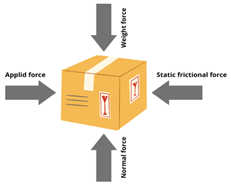When we examine Newton's laws of motion, we must recognize that the types of motions we witness on Earth do not always appear to satisfy these laws, because extraneous variables act on earth-bound objects.
The majority of these include some form of frictional force. Friction is a vital subject to grasp, so let's go over it in depth. When the force surpasses the restricting friction, the object begins to move, and static friction is replaced by kinetic friction.
This page discusses all of the fascinating aspects of kinetic friction.
What is kinetic friction?
"Kinetic refers to the resistance to motion induced by the contact between a substrate and the thing moving against it."
Or
"Kinetic friction" refers to the force that hinders comparative wobbling motion.”
Formula
Kinetic friction, also known as sliding friction, is equal to k times the length of time that a normal force is applied to a body. The kinetic friction coefficient, k, is employed in this example. The kinetic friction coefficient changes based on the substance.
Fk = μk.N
Where k is the kinetic friction coefficient and N is the normal force exerted on the body. The following methodology may now be used to compute the normal force and coefficient of kinetic friction:
N = Fk/μk and μk = Fk/N
SI units
Because kinetic friction is characterized as a force that resists the mobility of moving vehicles, the SI unit of friction is associated with the Newton force (N).
Explanation
When you try to push something across the surface, such as a large box across the floor, you will notice that getting the box moving is more difficult than keeping it moving once it is up and running.
Values for kinetic friction’s coefficient also exist. These numbers will differ from the coefficient of static friction values for the same material. We can use this data to compute the amount of the kinetic frictional force acting on sliding objects.
Commonly involved vectors
We are now acquainted with a few vectors that are often used in physics. A box at rest on Earth will experience a weight force in the downward direction and a normal force in the upward direction.
If a horizontal force is exerted, an opposing frictional force will act on the item. If the applied force is small enough that it cannot move the box, the horizontal vectors cancel each other out.
Horizontal vector cancellation, like vertical vector cancellation, will keep the object at rest. Now, if you apply a greater force, such that this force results in an acceleration in the direction of force then the body will start moving.
As a result, we may anticipate seeing these four vectors in a lot more free body diagrams from now on.
Difference between static friction and kinetic friction
- The static friction tends to stop the motion of the body before moving, whereas the kinetic friction stops the motion during movement.
- Both quantities are independent of the surface of contact.
The Static friction coefficient is independent of the temperature of the surface.
- The kinetic friction coefficient is independent of mutual contact.
- μs is always greater than μk.
- Fs is always greater than Fk.
How to calculate kinetic friction:
Example 1:
Determine the kinetic frictional force operating between the shoes and the hardwood surface when a man walks on a wooden floor with a coefficient of kinetic friction of 0.6 and a normal force of 50N acting on it.
Solution:
Manual method
Step 1: Understand the statement and select the given data.
Normal force = N = 50N
Kinetic friction coefficient = μk = 0.6
Kinetic frictional force = Fk =?
Step 3: Enter the values into the above formula.
Fk = 0.6 × 50N
Fk = 30N
As a result, the calculated kinetic friction is 30 N.
MeraCalculator (a free calculator’s website)can be used to determine kinetic friction, normal force, and kinetic friction coefficient.
Example 2:
Calculate the kinetic frictional force acting between the nail and the hammer if a man strikes it with a coefficient of kinetic friction of 0.7 and a normal force of 70N.
Step 1:Write down the provided information
Normal force = N = 70N
Kinetic friction coefficient = μk = 0.7
Kinetic frictional force = Fk =?
Step 2:Write the general formula
Fk = μk.N
Step 3: Enter the values into the above formula.
Fk = 0.7 × 70N
Fk = 49N
As a result, the calculated kinetic friction is 49N.
Example 3:
If
a metal disc is rolling on a concrete floor with kinetic friction of 20N and a
normal force of 66N acting on it, calculate the coefficient of kinetic friction
operating between the metal disc and the concrete road.
Step 1: Write the provided information.
Normal force = N
= 66N
Kinetic friction
coefficient = μk =?
Kinetic
frictional force = Fk = 20N
Step 2: Write a general formula
Fk = μk.N
Step 3: Enter the values into the above formula.
20N= μk* 66N
μk = 20N/66N
μk = 0.3030N
As a result, the calculated coefficient of kinetic friction is 0.3030N.
The abovementioned problem can also be calculated by using a kinetic friction calculator.
Summary:
Finally, I hope that this article has made you understand difference between static friction and kinetic friction. It's easy to grasp the role of the kinetic friction coefficient in the relative movements of objects once you've defined it.
The coefficient of kinetic friction between rubber and roads, for example, is 0.4, while metal and wood have a coefficient of 0.7. This coefficient can be computed manually or with the help of a kinetic friction calculator.



